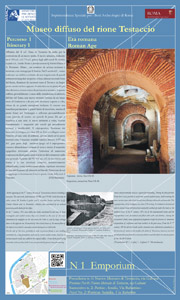
![]()

The valley of Testaccio spreads out for 600,000 square metres, is bounded to the north and west by the Tiber river banks, to the east by the via Marmorata and to the south by the Aurelian walls, and shows an urban fabric rich of historical evidences. From the 2nd century BC, when the ancient docking of Rome near the Foro Boario became inadequate for the city needs, the Testaccio plain was destined to the construction of a new port (Emporium), and a building behind it, the so-called Porticus Aemilia, used probably for goods storage or, according to a recent hypothesis, might correspond to the ancient docks along the river Tiber (Navalia). Then, during the republican age (II-I century B. C.), were built buildings for goods conservation and storage (Horrea Galbana, Lolliana, Severiana, etc.). In the Imperial age (I-III century AD) the buildings for goods conservation and storage were enlarged and restored and a large organized dump of oil amphoras was created (Monte dei Cocci or Monte Testaccio). Testaccio became the commercial district of ancient Rome. At the southern boundary of the “rione”, along the Aurelian Walls, which mark the inclusion of the commercial district in the ancient city walls, there are the Porta San Paolo, a gate of the ancient walls, and the Pyramid of Cestius, a monumental tomb of the I century B.C., which was enclosed into the new walls. The Aurelian walls became a strong urban feature that is still a sign of the ideal borderline between the town centre and the contemporary city